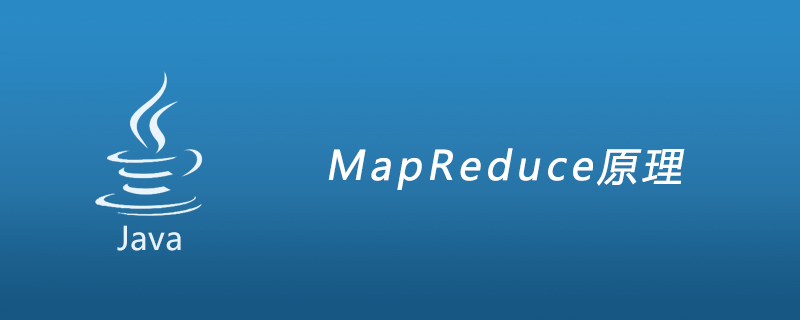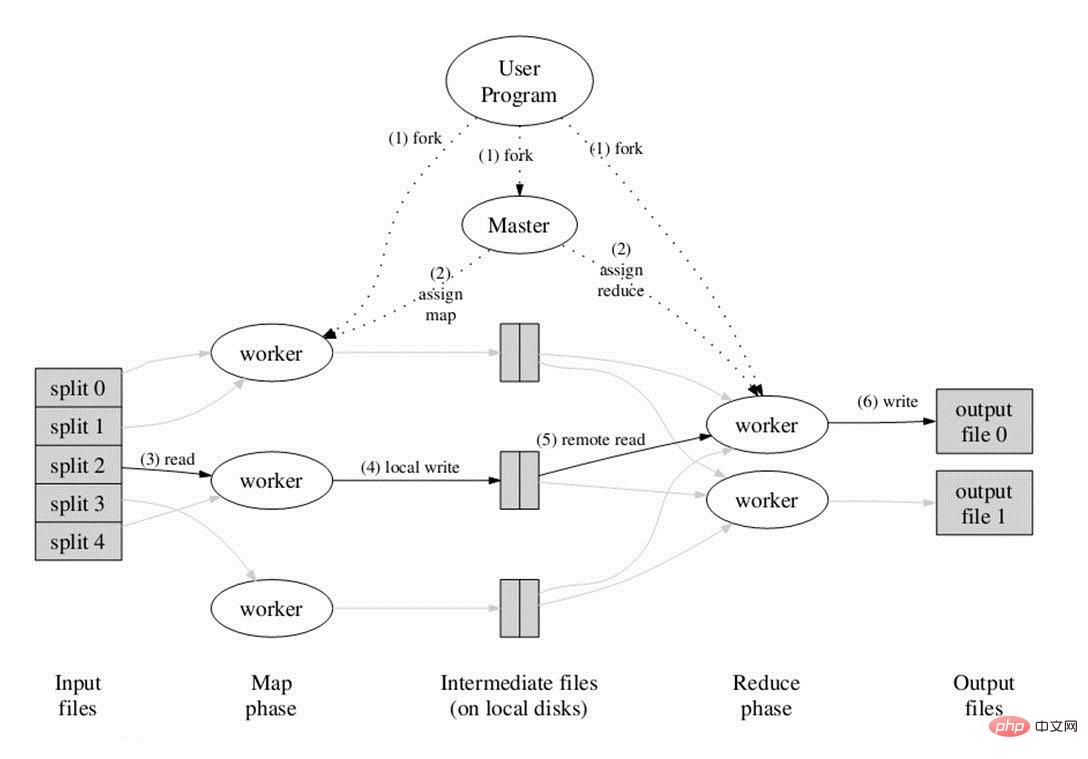MapReduce principle
MapReduce is a programming model for parallel operations on large-scale data sets (larger than 1TB). The concepts "Map" and "Reduce", which are their main ideas, are borrowed from functional programming languages, as well as features borrowed from vector programming languages.

It greatly facilitates programmers to run their own programs on distributed systems without knowing distributed parallel programming. The current software implementation specifies a Map function to map a set of key-value pairs into a new set of key-value pairs, and specifies a concurrent Reduce function to ensure that all mapped key-value pairs are Each of them share the same set of keys.
Working principle(Recommended learning: Java video tutorial)
MapReduce execution process
 The above picture is the flow chart given in the paper. Everything starts from the user program at the top. The user program is linked to the MapReduce library and implements the most basic Map function and Reduce function. The order of execution in the figure is marked with numbers.
The above picture is the flow chart given in the paper. Everything starts from the user program at the top. The user program is linked to the MapReduce library and implements the most basic Map function and Reduce function. The order of execution in the figure is marked with numbers.
1. The MapReduce library first divides the input file of the user program into M parts (M is user-defined). Each part is usually 16MB to 64MB, as shown on the left side of the figure, divided into split0~4; then Use fork to copy the user process to other machines in the cluster.
2. One copy of the user program is called master, and the others are called workers. The master is responsible for scheduling and allocating jobs (Map jobs or Reduce jobs) to idle workers. The number of workers can also be determined by the user. Specified.
3. The worker assigned to the Map job begins to read the input data of the corresponding shard. The number of Map jobs is determined by M and corresponds to split one-to-one; the Map job extracts the key from the input data. Value pairs, each key-value pair is passed to the map function as a parameter, and the intermediate key-value pairs generated by the map function are cached in memory.
4. The cached intermediate key-value pairs will be regularly written to the local disk and divided into R areas. The size of R is defined by the user. In the future, each area will correspond to a Reduce job; these The location of the intermediate key-value pair will be notified to the master, and the master is responsible for forwarding the information to the Reduce worker.
5. The master notifies the worker assigned the Reduce job where the partition it is responsible for is located (there must be more than one place, and the intermediate key-value pairs generated by each Map job may be mapped to all R different partitions), After the Reduce worker reads all the intermediate key-value pairs it is responsible for, it first sorts them so that key-value pairs with the same key are gathered together. Because different keys may be mapped to the same partition, that is, the same Reduce job (who has fewer partitions), sorting is necessary.
6. The reduce worker traverses the sorted intermediate key-value pairs. For each unique key, it passes the key and associated value to the reduce function. The output generated by the reduce function will be added to the output of this partition. in the file.
7. When all Map and Reduce jobs are completed, the master wakes up the genuine user program, and the MapReduce function call returns the code of the user program.
After all executions are completed, the MapReduce output is placed in the output files of R partitions (each corresponding to a Reduce job). Users usually do not need to merge these R files, but use them as input to another MapReduce program for processing. During the entire process, the input data comes from the underlying distributed file system (GFS), the intermediate data is placed in the local file system, and the final output data is written to the underlying distributed file system (GFS). And we should pay attention to the difference between Map/Reduce jobs and map/reduce functions: Map jobs process a shard of input data and may need to call the map function multiple times to process each input key-value pair; Reduce jobs process the intermediate keys of a partition Value pairs, during which the reduce function is called once for each different key, and the Reduce job finally corresponds to an output file.
For more Java-related technical articles, please visit the Java Development Tutorial column to learn!
The above is the detailed content of MapReduce principle. For more information, please follow other related articles on the PHP Chinese website!

Hot AI Tools

Undresser.AI Undress
AI-powered app for creating realistic nude photos

AI Clothes Remover
Online AI tool for removing clothes from photos.

Undress AI Tool
Undress images for free

Clothoff.io
AI clothes remover

Video Face Swap
Swap faces in any video effortlessly with our completely free AI face swap tool!

Hot Article

Hot Tools

Notepad++7.3.1
Easy-to-use and free code editor

SublimeText3 Chinese version
Chinese version, very easy to use

Zend Studio 13.0.1
Powerful PHP integrated development environment

Dreamweaver CS6
Visual web development tools

SublimeText3 Mac version
God-level code editing software (SublimeText3)

Hot Topics
 1666
1666
 14
14
 1425
1425
 52
52
 1327
1327
 25
25
 1273
1273
 29
29
 1252
1252
 24
24
 Is the company's security software causing the application to fail to run? How to troubleshoot and solve it?
Apr 19, 2025 pm 04:51 PM
Is the company's security software causing the application to fail to run? How to troubleshoot and solve it?
Apr 19, 2025 pm 04:51 PM
Troubleshooting and solutions to the company's security software that causes some applications to not function properly. Many companies will deploy security software in order to ensure internal network security. ...
 How do I convert names to numbers to implement sorting and maintain consistency in groups?
Apr 19, 2025 pm 11:30 PM
How do I convert names to numbers to implement sorting and maintain consistency in groups?
Apr 19, 2025 pm 11:30 PM
Solutions to convert names to numbers to implement sorting In many application scenarios, users may need to sort in groups, especially in one...
 How to simplify field mapping issues in system docking using MapStruct?
Apr 19, 2025 pm 06:21 PM
How to simplify field mapping issues in system docking using MapStruct?
Apr 19, 2025 pm 06:21 PM
Field mapping processing in system docking often encounters a difficult problem when performing system docking: how to effectively map the interface fields of system A...
 How to elegantly obtain entity class variable names to build database query conditions?
Apr 19, 2025 pm 11:42 PM
How to elegantly obtain entity class variable names to build database query conditions?
Apr 19, 2025 pm 11:42 PM
When using MyBatis-Plus or other ORM frameworks for database operations, it is often necessary to construct query conditions based on the attribute name of the entity class. If you manually every time...
 How does IntelliJ IDEA identify the port number of a Spring Boot project without outputting a log?
Apr 19, 2025 pm 11:45 PM
How does IntelliJ IDEA identify the port number of a Spring Boot project without outputting a log?
Apr 19, 2025 pm 11:45 PM
Start Spring using IntelliJIDEAUltimate version...
 How to safely convert Java objects to arrays?
Apr 19, 2025 pm 11:33 PM
How to safely convert Java objects to arrays?
Apr 19, 2025 pm 11:33 PM
Conversion of Java Objects and Arrays: In-depth discussion of the risks and correct methods of cast type conversion Many Java beginners will encounter the conversion of an object into an array...
 How to use the Redis cache solution to efficiently realize the requirements of product ranking list?
Apr 19, 2025 pm 11:36 PM
How to use the Redis cache solution to efficiently realize the requirements of product ranking list?
Apr 19, 2025 pm 11:36 PM
How does the Redis caching solution realize the requirements of product ranking list? During the development process, we often need to deal with the requirements of rankings, such as displaying a...
 E-commerce platform SKU and SPU database design: How to take into account both user-defined attributes and attributeless products?
Apr 19, 2025 pm 11:27 PM
E-commerce platform SKU and SPU database design: How to take into account both user-defined attributes and attributeless products?
Apr 19, 2025 pm 11:27 PM
Detailed explanation of the design of SKU and SPU tables on e-commerce platforms This article will discuss the database design issues of SKU and SPU in e-commerce platforms, especially how to deal with user-defined sales...




